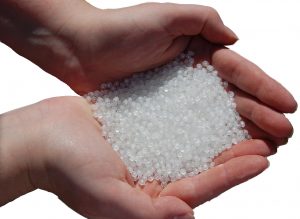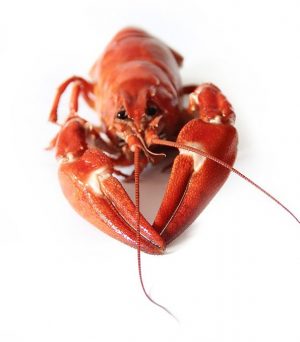The amount of plastic in the world’s oceans has long been cause for deep concern with the North Atlantic Garbage Patch and its Pacific equivalent being well publicised.
Since around 2012 when the plastic microbeads used in cosmetics began hitting the headlines and were subsequently banned, a new issue has reached public consciousness: microplastics.
Subsequent studies have found that microplastics are ubiquitous in our oceans and tap water, but what might the effects of consuming microplastics actually be for humans, and can we limit our exposure?
What Are Microplastics?
Microplastics comprise tiny fibres from nylon clothes and other synthetic textiles, microbeads from cosmetics as well as fragments of larger plastic items that have broken down in the natural environment.

plastic pellets by gentlemanrock under cc 2.0
The U.S. National Oceanic & Atmospheric Administration classifies microplastics as being between 5mm and 333μm (micrometres/microns) in size but this lower limit is only due to the 333μm mesh nets used to capture the particles.
Other studies have identified particles as small as 10nm (nanometres) and this is one of the major unanswered questions – how small do the plastic particles actually get?
This is a crucial question as the smaller the size of the plastic particles, the more likely they are to cross biological barriers (such as cell membranes) and cause tissue damage.
So Are Microplastics Harmful?
This is another ‘unknown’ and research is limited and sometimes contradictory. Though no research has conclusively found that microplastic particles themselves are harmful, there is some evidence that they can absorb toxic chemicals and that conditions in mammalian digestive systems facilitate the release of those toxins.
There is also evidence that plastic nanoparticles can potentially migrate through the intestinal wall during digestion, but whether they stay in the gut lining or enter the blood stream is not clear. As yet the effect of this is unknown and the World Health Organisation have recently announced a review into the potential health impacts.
One study by Lund University in Sweden demonstrated that nanoplastic particles lodged in the brains of fish affected their behaviour, making them eat slower and explore their surroundings less. However there is currently no evidence that nanoplastics penetrate brain tissue in humans, let alone affect behaviour.
How Are Humans Consuming Microplastics?
Seafood was the first source identified through which humans are consuming microplastics. Plastic particles flushed into the natural environment are eaten by plankton, which are then eaten by fish and crustaceans with the plastic particles working their way up the food chain and onto our plates.

Either way the seafood we eat is likely to be contaminated by microplastic particles with mussels reported to be particularly susceptible to microplastic contamination.
However, new research published earlier this year has shown that the microplastics in household and workplace dust are a more likely source of micro-plastic consumption in humans than mussels.
According to researchers at Heriot-Watt University in Edinburgh, 114 pieces of microplastic settle on a dinner plate during the 20 minute duration of a meal, adding up to anywhere between 13,000 and 68,000 pieces per year.
Consuming plastic particles is only one of the issues. There is also growing evidence that plastic packaging could be leaching harmful chemicals into our food, including Bisphenol A and phthalates which are known to have disruptive effects on the human endocrine system.
In addition to this, microplastic contamination has been detected in the tap water of various countries around the world. A recent study by Orb Media found that European nations such as the UK, Germany and France had a microplastic contamination rate of 72%.
The microplastic prevalence in seafood, tap water and dust particles amongst others means that the vast majority of people will have ingested microplastics in some way or another.
What Can We Do About It?
Directly limiting microplastic ingestion is extremely difficult due to the multiple areas for contamination and with no definitive answer as to how small plastic particles can get, it's not possible to say exactly how to limit your exposure.
What you can do is limit your exposure in the areas we know microplastics exists. Reducing the amount of plastic you use, from cutting out bottled water and disposable coffee cups to avoiding food with unnecessary plastic packaging will help long-term.
One of the most well publicised causes of microplastic contamination are the now banned microbeads found in beauty products, toothpastes and other household products. Many of these are unfiltered by sewage systems and so end up in the sea or other water supplies with the potential to end up back in our food chain. Selecting environmentally friendly cleaning and beauty products will also have a positive long-term affect.
If you are concerned about microplastics in your water supply, you may also want to consider a water filter for your domestic or business premises. Although microplastic particles vary in size - with some of the finer particles practically impossible to remove with filtration - some of the larger particles can be removed through a high-grade filtration system such as a ceramic water filter or reverse osmosis system.
Summary
Microplastics are prevalent in society today and could be in places we have not identified yet. While research continues there are no conclusive answers as to how small the particles can be or the impact of the particles on humans when consumed.
One way to reduce your exposure to microplastics is simply to buy and use less plastic. Consider buying a reusable bottle and reducing the amount of bottled water you buy, for instance. You can still obtain bottled quality water from  your tap with an under sink filtration system such as the Water Gem.
your tap with an under sink filtration system such as the Water Gem.
For a more long-term solution, both individuals and policy-makers need to work hard to reduce the amount of single-use plastic that ends up in our oceans and water supply.
